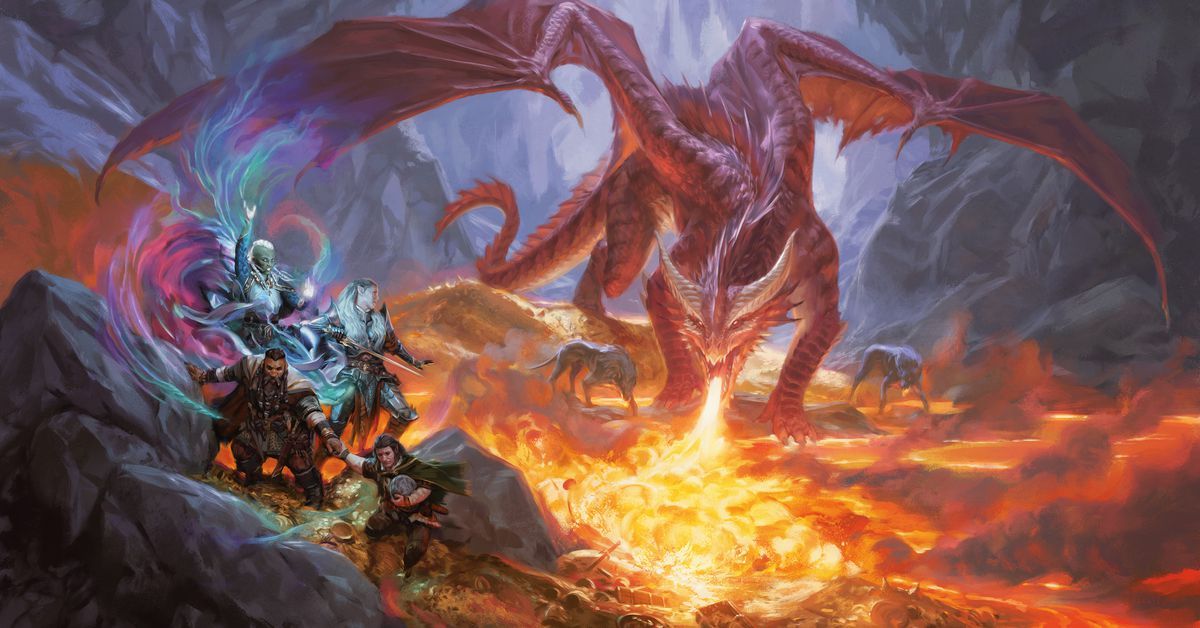D&D’s revised core rulebooks will help create more Dungeon Masters
Dungeons & Dragons has gone mainstream. Nearly 50 years after its invention, more people than ever before are rolling dice with their friends. Meanwhile, major media crossovers like Stranger Things and Dungeons & Dragons: Honor Among Thieves are making sure that even the long-held stigmas attached to the game are falling by the wayside. But, in many ways, the game’s development team at Wizards of the Coast has fallen a bit behind, and now it’s time for a revision. A new set of core rulebooks is on the way... just be careful not to call it 6th edition.
Following the launch of the game’s 5th edition in 2014, Wizards spent the better part of a decade tinkering with and iterating on its winning formula. That process culminated in early 2022 with the Rules Expansion Gift Set: three volumes titled Xanathar’s Guide to Everything, Tasha’s Cauldron of Everything, and Mordenkainen Presents: Monsters of the Multiverse. Now, developers say, it’s time to go back to the drawing board and formally integrate what worked in those three new books into a full-fledged update of 5th edition D&D. That means new versions of the original three core rulebooks, a triad known to fans as the Player’s Handbook (PHB), the Dungeon Master’s Guide (DMG), and the Monster Manual (MM). Along the way, Wizards said it will also endeavor to make those books richer and more usable than ever before — all while retaining continuity and compatibility with every 5th edition product that has come before.
“For so many people, those books are their introductory experience to the game,” said game design architect Chris Perkins in a group interview with press earlier this month. “Those books are denser than some of our later books, the monsters aren’t as easy or as fun to play as some of our more recent books, and finding things is not as easy. [...] So making sure that our gateway to the game is as strong, as beautiful, [and] as accessible as possible I think is very important for the longevity of the game — and just for people’s enjoyment.”
Here’s what you should expect inside the updated 2024 editions of Dungeons & Dragons’ core rulebooks.
Player’s Handbook
Player’s Handbook (2024) will have a lot more pages in it than the original, which is among D&D’s largest books, clocking in at a hefty 320 pages. But the updated version likely won’t have as many words.
The new PHB designers said they are working hard to streamline its language throughout and to provide more art to players than ever before. There will be new images for each of the book’s 12 core classes — barbarian, bard, cleric, druid, fighter, monk, paladin, ranger, rogue, sorcerer, warlock, and wizard — as well as for each of the 48 sub-classes included inside (four total for each core class). Most importantly, that art will highlight the full spectrum of real-world human diversity.
While it’s important that potential players be able to see themselves on the pages of the Player’s Handbook (2024), it’s likewise important that newcomers have the best on-ramp possible to actually learn to play the game. For that reason, character creation is being moved back behind the game’s most fundamental rules. This new expression of the 5th edition PHB will actually teach you how to play the game before it invites you to roll up your first character.
And, when you do decide to make that first character, you’ll have more choices than ever before, thanks to more than 144 options for your character’s background. Whether they started life as a soldier or a scholar will also be more important than it was in 2014. That’s because the new Player’s Handbook (2024) will offload important features like ability score improvements, first-level feats, and more from your character’s biological roots to their cultural and socioeconomic roots — similar to what was proposed as a new, optional rule in Tasha’s Cauldron of Everything.
“The ‘character origins’ chapter will also include guidance on alignment [and] languages,” said game design architect Jeremy Crawford. “But the focus is on species [formerly called race] and backgrounds. How we are framing it — and this is really building on work we did in Tasha’s Cauldron of Everything — is taking those two components of the character [and] combining them to create a glimpse of who their character was before they became an adventurer.”
Player’s Handbook (2024) will also include rules for creating backgrounds of your own. “We’re basically giving people more tools than they’ve ever had,” Crawford said.
Ability scores like strength, dexterity, and wisdom will also be locked in much later in the character creation process. Players will of course be able to use existing methods to generate those scores, like the “standard array” and the “point-buy system” of old. But going forward, the classes themselves will recommend what ability scores to take. These, and other changes in the PHB, are all designed to get people playing faster.
“Let’s get to the play,” Crawford said, “while still giving people the customization options that they’re used to. Now you decide, as a player or a DM: Am I gonna take the time to build this myself? Or am I going to use one of these get-going-quick options that the book now provides?”
Dungeon Master’s Guide
While Wizards has repeatedly telegraphed its moves with the changes coming to the Player’s Handbook (2024), perhaps the most substantive changes in the core rulebooks will come with the Dungeon Master’s Guide (2024). That’s because, according to Perkins, it’s been a bit of a mess from the beginning.
“Back in 2013, our team was a lot smaller,” Perkins said. “We were pushing through all the core rulebooks at the same time, as well as the Starter Set, and to say Jeremy and I were overworked and had a lot on our plate was an understatement at the time.
“Now that we’ve been able to circle back around, eight years of conversations later,” Perkins continued, “we’ve got a number of things we want to do to the DMG which we would have liked to have done many years ago.”
At the core of the Dungeon Master’s Guide (2024) will be a newly revised section on creating your own homebrew campaign, which will include a sample campaign setting. Then the book will show budding DMs how to build it out with the needs and desires of their players in mind.
“I don’t want to use the word ‘stripped-down,’ but let’s say it’s very condensed,” Perkins said. “But it is a complete setting, and you can take this campaign skeleton and add some flesh to it. Decide where you want to place your campaign in this setting, and then make it your own. [We] give you a poster map that you can use of this campaign setting, and give you hooks within the campaign setting to help inform your decision about which parts of the campaign you want to use, [so that you can decide] which conflicts you think are going to be important in this game.”
While the order and format of the information inside Dungeon Master’s Guide (2024) is still a work in progress, Perkins said that it will include lots of important information that was overlooked in 2014. What’s the purpose of a Dungeon Master’s screen, for instance, and how do you use it? What do you do with a player who is being disruptive at the table? How do you plan your gaming sessions around other people’s lives? And how much do you really need to know about the rules before you start playing as the DM?
“Where do I start? How do I get up to speed? How do I become like [Matt Mercer and other now-famous DMs]?” Perkins asked. “How do I make sure my game is actually delivering on player expectations? [...] We can front-load all that information so that when we get toward the middle of the book, DMs are prepared to talk about some other conversations, not about dealing with issues of starting up the game and addressing matters at the game table, but now we can talk about the creative part of DMing.”
Monster Manual
Finally, the Monster Manual, a book rarely seen by the average D&D player, is likely to have the most new content out of all three books. That’s because Monster Manual (2024) will include more than 500 monsters in all and, for the first time in franchise history, each and every one of them will get its own unique piece of art.
But perhaps the biggest surprise is how many high-level monsters will be included, each one fully capable of giving a level 20 group of heroes a run for their money.
“As we looked at filling out the monstrous roster in this book,” Crawford said, “we wanted to make sure that we had more high-challenge-rating monsters. So you’re gonna see a whole set of new big bads in this book, with an emphasis on creature types that did not have really high-CR representatives.”
As an example, Crawford noted that the Monster Manual (2014) shipped with a whole lot of high-level dragons and fiends. Monster Manual (2024) will include some as well, but it will also include high-level fae, constructs, elementals, and oozes.
“Imagine an ooze that can wipe out an entire town just by rolling over it,” Crawford said. “And it’s also important for us to point out that none of the existing monsters will have their challenge ratings changed. Because we are maintaining stability of the current edition, and because many existing adventures assume that monsters have a particular CR, we are ensuring that the monsters carrying forward from the 2014 Monster Manual have the same CR that they had when they were written.”
An end to the ‘edition wars’
Throughout the multi-day press event, developers from Wizards of the Coast returned again and again to the fact that 5th edition D&D isn’t going away. D&D’s fourth edition, they said, was a kind of slow-rolling disaster that very nearly brought about the end of the franchise as we know it. The current 5th edition ruleset was crafted with input from hundreds of thousands of players during a multi-year playtest that preceded its 2014 launch. There’s no reason to throw out that work in favor of a “new edition” of the game, and the 2024 updates of the three core rulebooks have been created with that firmly in mind.
“We also acknowledge that what we’re doing is special,” Crawford said. “It has not been done before for Dungeons & Dragons. This is the first time that the game has ever done a major revision of an edition, and then continued that edition — and made it so that you could continue using the products that you already have.”
According to Wizards, you won’t need to stop doing what you’re doing at the table right now or change anything about your at-home game to make room for these new, updated rules in your party. Everything written inside the original 5th edition books is still valid, still legal to play. It’s just that they hope these new updated versions can better set the table for D&D’s continued growth into the future – making more player characters and mentoring more Dungeon Masters than ever before.
We’ll know for sure if they’ve succeeded when all the three books finish rolling off the presses sometime next year.
Source: Polygon


